Hummingbirds are some of the most fascinating creatures in the animal kingdom, known for their incredible agility, iridescent feathers, and 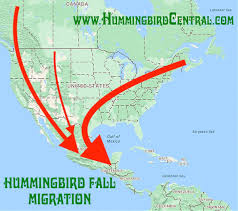 astonishing migratory journeys. These small birds, with their distinctive hovering flight and rapid wing beats, traverse vast distances each year as part of their seasonal migration.
astonishing migratory journeys. These small birds, with their distinctive hovering flight and rapid wing beats, traverse vast distances each year as part of their seasonal migration.
In this article, we’ll explore the key aspects of hummingbird migration, from the species involved to their migration routes, the challenges they face, and the fascinating ways in which they navigate over long distances. We will also examine the conservation efforts necessary to ensure these migratory birds continue to thrive in an ever-changing world.
Introduction to Hummingbird Migration
The males typically migrate north before the females because their main role during migration and breeding is to establish and defend territory. By arriving early, the males can claim prime feeding areas and nesting sites before the females arrive. This gives them a better chance to attract a mate, as females tend to choose males based on their territorial success and ability to provide access to good resources. Once the males are settled in their territories, the females can then arrive later to find a suitable mate and start nesting. It’s a strategy that helps ensure the males are in optimal condition to court the females, who then can successfully raise the offspring.
Hummingbird migration is one of nature’s most remarkable feats. Each year, millions of hummingbirds travel thousands of miles between their breeding grounds in North America and their wintering grounds in Central and South America. These tiny birds, some no larger than a thumb, are capable of enduring long, non-stop flights, crossing formidable natural barriers like the Gulf of Mexico. Despite their small size, hummingbirds exhibit an incredible level of endurance and efficiency during migration, powered by a combination of innate instincts, biological adaptations, and environmental cues.
Scientists have long been captivated by the mystery of hummingbird migration, and researchers continue to study the mechanisms behind their incredible navigational abilities. Understanding these birds’ migratory behavior is not only important for their conservation but also sheds light on broader ecological processes, including the impact of climate change on migratory species.
Hummingbird Species and Their Range
There are over 330 species of hummingbirds, distributed across the Americas, with the highest diversity in Central and South America. However, only a select few species are migratory. Among these, the Ruby-throated Hummingbird is perhaps the most well-known, particularly for its migration across the Gulf of Mexico, which remains a subject of fascination for ornithologists.
Common Migratory Species of Hummingbirds
Ruby-throated Hummingbird (Archilochus colubris)
1. The Ruby-throated Hummingbird is arguably the most iconic and best-known migratory hummingbird in North America. These dazzling
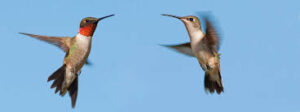 little birds are primarily found in the eastern and central United States, as well as parts of Canada. Their bright red throat patch (or “gorget”) in males gives them their name, and they are often the species most commonly seen at backyard feeders in the U.S. during the warmer months.
little birds are primarily found in the eastern and central United States, as well as parts of Canada. Their bright red throat patch (or “gorget”) in males gives them their name, and they are often the species most commonly seen at backyard feeders in the U.S. during the warmer months.
Migration Patterns
The Ruby-throated Hummingbird’s migration is truly remarkable, as it is one of the few hummingbird species to make a non-stop, trans-oceanic flight across the Gulf of Mexico. Each year, in late summer or early fall, 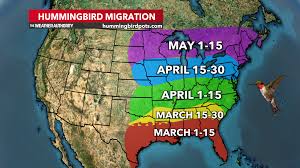 these birds embark on their journey from their breeding grounds in North America to their wintering grounds in Central America, primarily in southern Mexico.
these birds embark on their journey from their breeding grounds in North America to their wintering grounds in Central America, primarily in southern Mexico.
The journey is not just long; it’s also incredibly energy-intensive. The Ruby-throated Hummingbird must rapidly accumulate fat reserves in the weeks leading up to migration. On average, these birds travel around 1,500 miles (2,400 km) southward, often flying non-stop for up to 18 hours over the Gulf of Mexico without any food or water. This feat is particularly impressive, given that the average weight of a Ruby-throated Hummingbird is only about 2.5 grams (0.09 ounces).
The Ruby-throated Hummingbird’s migration also serves as a model for other species, offering insights into the behavior and physiology of migratory birds in general. Scientists have long been fascinated by their ability to navigate long distances, relying on environmental cues such as sunlight, magnetic fields, and visual landmarks to find their way.
Breeding and Wintering Habitats
During the breeding season, Ruby-throated Hummingbirds can be found in gardens, woodlands, and open habitats with abundant flowers, especially in the eastern U.S. As they prepare for migration, they rely heavily on feeders, where they can rapidly accumulate the energy needed for the long flight south. Their wintering habitats are in tropical regions of Central America, especially southern Mexico and parts of Belize, where they spend the colder months feeding on nectar and insects in the lush, warm climate.
2. Rufous Hummingbird (Selasphorus rufus)
The Rufous Hummingbird is one of the most common migratory species found in the western U.S. and Canada, and it is known for its bright
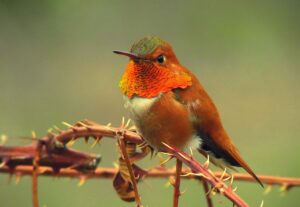
orange-red plumage and its fierce, territorial behavior. This species is particularly notable for its long-distance migration, as it travels through much of the western U.S., across the southern states, and into Mexico for the winter.
Migration Patterns
The Rufous Hummingbird’s migration is one of the longest and most predictable of all hummingbird species. In late summer or early fall, Rufous Hummingbirds leave their breeding grounds in the Pacific Northwest, British Columbia, and parts of southern Canada. Their migration route takes them southward through California, Arizona, and New Mexico, and into Mexico. This species is often observed in the southwestern U.S. during the late fall and early winter months before finally arriving in their wintering grounds in Mexico.
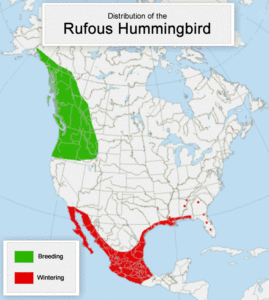 One of the most fascinating aspects of the Rufous Hummingbird’s migration is its migratory behavior. These birds tend to travel in a more linear route compared to some other species, and their migration is considered one of the most energetically demanding in terms of the total distance covered. Some Rufous Hummingbirds even travel through the mountainous regions of the western U.S., which means they may have to contend with challenging weather conditions, such as high winds or snow in the late fall.
One of the most fascinating aspects of the Rufous Hummingbird’s migration is its migratory behavior. These birds tend to travel in a more linear route compared to some other species, and their migration is considered one of the most energetically demanding in terms of the total distance covered. Some Rufous Hummingbirds even travel through the mountainous regions of the western U.S., which means they may have to contend with challenging weather conditions, such as high winds or snow in the late fall.
Rufous Hummingbirds are also known for their remarkable ability to return to the exact same locations year after year, following the same migratory routes and stopover sites. This precise navigation, paired with their fierce territorial nature, makes them a favorite among birdwatchers, who can often spot these birds in backyards, especially in southern regions of the U.S. during the fall and winter months.
Breeding and Wintering Habitats
Rufous Hummingbirds breed in mountainous regions of the western U.S., particularly in areas that offer abundant nectar-producing plants like columbines, penstemons, and wildflowers. As they prepare for migration, they engage in intense feeding behaviors to build up their fat stores, which are crucial for sustaining them during the long journey south.
Their wintering grounds are in Mexico, particularly in the Sierra Madre Occidental and southern Baja California. These regions provide a warm climate and a consistent food supply, allowing the birds to continue feeding and maintaining their energy levels until it is time to return north for the next breeding season.
3. Black-chinned Hummingbird (Archilochus alexandri)
The Black-chinned Hummingbird is another migratory species commonly found in the southwestern U.S., primarily in Arizona, New Mexico,
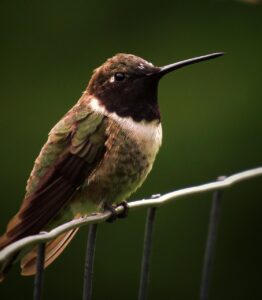 and parts of Texas. This species is easily identified by the black patch on the throat of males, contrasting with the bright green plumage of both males and females.
and parts of Texas. This species is easily identified by the black patch on the throat of males, contrasting with the bright green plumage of both males and females.
Migration Patterns
Black-chinned Hummingbirds have a relatively short but significant migratory journey, traveling southward from their breeding grounds in the southwestern U.S. to wintering areas in northern Mexico. They typically migrate between late summer and early fall, and their migration is often influenced by the availability of food resources and changes in temperature.
Unlike the Ruby-throated Hummingbird, which crosses vast open waters like the Gulf of Mexico, the Black-chinned Hummingbird migrates over land. However, it still faces considerable challenges during its journey, particularly in navigating through desert regions and across mountain ranges.
Breeding and Wintering Habitats
Breeding for the Black-chinned Hummingbird takes place in the southwestern U.S., where it favors habitats with abundant flowering plants and shrubs. The males are territorial, aggressively defending feeding areas from other hummingbirds and insects. During the migration period, these birds feed intensively on nectar from agave, yucca, and other desert plants, which provide the energy they need for the journey south.
During the winter months, the Black-chinned Hummingbird migrates to northern Mexico, where it thrives in arid and semi-arid landscapes. The warm climate of the region, combined with abundant food sources, ensures that these hummingbirds can continue their migratory cycle and return to their breeding grounds in the U.S. the following spring.
4. Calliope Hummingbird (Selasphorus calliope)
The Calliope Hummingbird is the smallest bird species in North America and is known for its striking iridescent magenta throat patch. It is
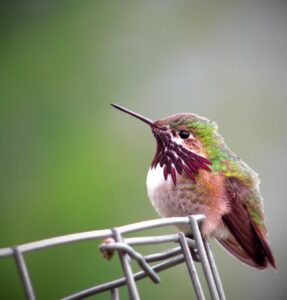 primarily found in the western U.S. during the breeding season and migrates to the southwestern U.S. and parts of Mexico for the winter.
primarily found in the western U.S. during the breeding season and migrates to the southwestern U.S. and parts of Mexico for the winter.
Migration Patterns
The Calliope Hummingbird migrates in a relatively similar manner to the Rufous Hummingbird, but its migratory route is generally more focused on the western regions of the U.S. and Canada. These birds breed in mountainous areas, particularly in the western U.S., and as autumn approaches, they travel south to spend the winter in Mexico, primarily in areas such as southern Arizona, New Mexico, and parts of Mexico.
The Calliope Hummingbird has an extraordinary ability to migrate long distances, considering its diminutive size. These tiny birds often face challenges navigating through mountainous terrain, where weather patterns can change rapidly, making their long migration particularly perilous.
Breeding and Wintering Habitats
The Calliope Hummingbird breeds in high-elevation habitats in the western U.S., particularly in regions with abundant wildflowers, such as mountain meadows and open woodlands. These areas provide both nectar and insects, which are essential for the birds’ energy needs during the breeding season.
During the winter, the Calliope Hummingbird migrates to lower elevations in the southwestern U.S. and parts of Mexico, where it feeds on desert flowers and other nectar-rich plants. The warm climate of the region provides a stable environment for the bird to survive the winter months, before it heads back north in the spring to breed once more.
Conclusion
The migratory species of hummingbirds represent a diverse array of behaviors, adaptations, and challenges. While each species follows its own unique migratory route, all migratory hummingbirds share the same needs. They are all needing abundant food sources, favorable weather conditions, and safe passage during their long journeys. Whether crossing oceans or navigating mountain ranges, these tiny birds demonstrate remarkable endurance, navigation skills, and energy reserves.These factors all make their migration one of the most extraordinary natural phenomena in the avian world.
Conserving these species requires not only protecting their breeding and wintering habitats but also ensuring that the migratory routes they follow remain intact, free from the dangers of habitat destruction and environmental disruption. By understanding the unique behaviors and migration patterns of these hummingbird species, we can contribute to efforts to safeguard their populations for future generations to marvel at.
Non-migratory Species
Not all hummingbird species migrate. Some species, such as the Anna’s Hummingbird (Calypte anna) in California and the Costa’s Hummingbird(Calypte costae) in the southwestern U.S., remain in their habitats year-round. These birds have adapted to milder climates and can survive through the winter by finding food sources and maintaining body temperature.
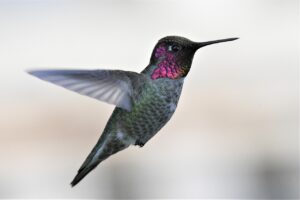
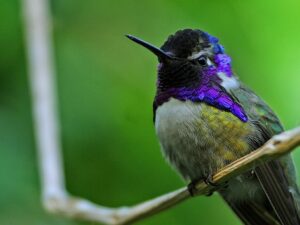
The Science of Migration
Migration is a complex process that involves the seasonal movement of animals from one location to another. This movement is done to typically to take advantage of more favorable conditions such as food availability, breeding opportunities, or better weather. For hummingbirds, migration is primarily driven by the need to find food and to avoid cold temperatures that could threaten their survival.
Hummingbird migration is different from many other birds in several respects. Most migratory birds travel in flocks, but hummingbirds tend to migrate alone, using their excellent navigation skills to find their way. Unlike larger birds, hummingbirds must also rely on fat storage for energy during their long journeys, as their small bodies burn energy at an incredibly fast rate.
Scientists believe that hummingbirds have a combination of innate migratory instincts and environmental cues that help them navigate. These birds rely on a variety of factors, such as changes in day length (photoperiod), temperature shifts, and the availability of food to signal when it is time to migrate.
Hummingbird Migration Routes: The Incredible Journeys of U.S. Hummingbirds
1. Ruby-throated Hummingbird
The Ruby-throated Hummingbird is the most common and widely recognized hummingbird species in the eastern United States.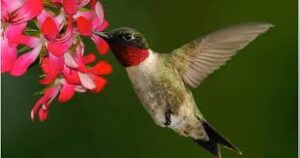
- Route:
- The Ruby-throated Hummingbird migrates from the eastern U.S. and southeastern Canada to Central America for the winter.
- One of the most incredible aspects of this species’ migration is its nonstop flight across the Gulf of Mexico.
- These tiny birds fly approximately 500 miles without stopping for food or rest. They rely on their fat reserves to fuel this journey.
- Their wintering grounds are typically in southern Mexico and Central America, where they enjoy a warmer climate and abundant nectar from tropical flowers.
- Timing:
- Migration begins in late summer to early fall, with most birds leaving the U.S. around September.
- Ruby-throated Hummingbirds return to the U.S. in early spring, generally from March to April, as temperatures warm up.
- Fun Fact: Ruby-throated Hummingbirds can travel up to 2,000 miles in total during their round-trip migration.
2. Rufous Hummingbird
Rufous Hummingbirds are a common species in the western U.S. and are known for their fiery plumage.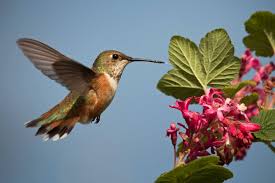
- Route:
- Rufous Hummingbirds breed in the western U.S. and Canada and migrate southward to Mexico for the winter.
- Their migration path is one of the longest among U.S. hummingbirds, with some birds traveling up to 2,000 miles.
- They pass through a variety of landscapes, including the Rocky Mountains and the desert regions of the southwestern U.S.
- While some Rufous Hummingbirds make a direct route to southern Mexico, others travel to more specific locations in the southern U.S. before continuing south.
- Timing:
- Rufous Hummingbirds begin their migration in late September to October and return to the U.S. between March and April.
- They are among the first hummingbirds to arrive in the spring, signaling the return of warmer weather.
- Fun Fact: Rufous Hummingbirds are known to be aggressive defenders of their feeding territories, even during migration.
3. Black-chinned Hummingbird
This species is primarily found in the southwestern U.S., especially in Arizona, New Mexico, and parts of Texas.
- Route:
- Black-chinned Hummingbirds migrate from the southern U.S. to northern Mexico.
- They travel through the deserts and mountainous regions of the southwestern U.S. before heading south.
- Unlike some other species, the Black-chinned Hummingbird’s migration is more localized within North America, with their wintering grounds focused in Mexico.
- Timing:
- These hummingbirds typically leave in late fall (October to November).
- They return to the southwestern U.S. around March, just as the weather begins to warm.
- Fun Fact: The Black-chinned Hummingbird is known for its distinctive black throat patch, which can appear more iridescent depending on the lighting.
4. Calliope Hummingbird
The Calliope Hummingbird is the smallest hummingbird in North America and has a range that stretches across the western U.S. and Canada.
- Route:
- Calliope Hummingbirds breed in the mountainous regions of the western U.S. and southern Canada, migrating to Mexico for the winter.
- They travel south through the Rocky Mountains, passing through the southwestern U.S. before reaching their warmer wintering grounds in Mexico.
- This species is one of the first to begin its migration in the fall.
- Timing:
- Calliope Hummingbirds typically start their migration in late summer, around late August or early September.
- They return to the U.S. in the spring, usually around mid-April, after spending several months in Mexico.
- Fun Fact: Despite their small size, Calliope Hummingbirds are known for their incredible endurance and long-distance flight capabilities.
5. Anna’s Hummingbird
Anna’s Hummingbird is a vibrant species found in the southwestern U.S., particularly in California.
- Route:
- Some Anna’s Hummingbirds are year-round residents along the California coast, where the mild climate provides a steady food
 source.
source. - However, those that do migrate move short distances within the southwestern U.S. and Mexico.
- They often stay within the warmer areas of southern California, Arizona, and Baja California, making their migration path much less dramatic than other species.
- Some Anna’s Hummingbirds are year-round residents along the California coast, where the mild climate provides a steady food
- Timing:
- For those that migrate, Anna’s Hummingbirds leave in fall and return to their territories in early spring.
- The coastal population tends to stay put, enjoying a steady supply of nectar.
- Fun Fact: Anna’s Hummingbirds are one of the few species of hummingbirds that can often be found year-round in the U.S., especially in southern California.
6. Broad-tailed Hummingbird
The Broad-tailed Hummingbird is found in high-altitude regions of the southwestern U.S. and migrates to Mexico during the colder months.
- Route:
- These hummingbirds breed in the mountainous regions of the Rocky Mountains and surrounding areas, migrating south to Mexico for
 the winter.
the winter. - Their migration path takes them through desert landscapes and mountain ranges, offering spectacular views of North America’s diverse ecosystems.
- These hummingbirds breed in the mountainous regions of the Rocky Mountains and surrounding areas, migrating south to Mexico for
- Timing:
- Broad-tailed Hummingbirds leave their breeding grounds in the fall, typically around September to October.
- They return in the spring, with most birds arriving back in late March to early April.
- Fun Fact: The Broad-tailed Hummingbird has a distinctive “whistling” sound made by its tail feathers when it flies.
7. Allen’s Hummingbird
Allen’s Hummingbird is a coastal species primarily found in southern California and Baja California.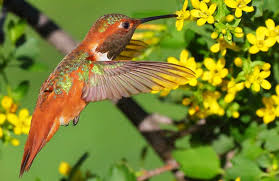
- Route:
- Allen’s Hummingbirds migrate from southern California and Baja California to Mexico, where they find a warmer climate and more abundant nectar.
- Their migration distance is relatively short compared to other species, staying within the southwestern region.
- Timing:
- They leave in the fall, typically around October, and return in the spring, between March and April.
- Fun Fact: Allen’s Hummingbirds are known for their striking metallic green and orange plumage, which is particularly vibrant in males.
Why Do Hummingbirds Migrate?
Hummingbirds migrate to find a reliable food source and to avoid cold weather. Nectar from flowers, as well as small insects, make up their diet, and these food sources can become scarce during the colder months in the northern U.S. Migration ensures that hummingbirds can continue feeding and surviving in a warm, abundant environment.
How Do Hummingbirds Navigate?
Hummingbirds have impressive navigational skills. They use a combination of sun positioning, the Earth’s magnetic field, and landmarks to guide their migration. They also rely on their incredible memory to remember migratory routes and stopover points, which helps them navigate with amazing accuracy.
Conclusion: The Remarkable Journeys of U.S. Hummingbirds
Hummingbird migration is a true marvel of nature. These tiny birds undertake incredible journeys each year, traveling thousands of miles in search of food and favorable weather conditions. Their resilience and navigational skills are nothing short of extraordinary. By understanding their migration routes, we can better protect these incredible species and the habitats they rely on.
This video presents an animated map showcasing the migration’s progress throughout the spring.
The Hummingbird Central website helps monitor the annual hummingbird migration across North America by relying on viewers to report their first sightings of the season. These sightings contribute to tracking how the migration unfolds and provide insight into the timing and routes of the birds’ journey.
The 2024 Spring Hummingbird Migration Map project kicked off in late January and ran through May 31, 2024, by which time most hummingbirds had reached their northern breeding grounds in Canada, where they establish nests and raise their young.
.The journey south typically takes several weeks to a few months, depending on the distance, with the birds arriving at their wintering grounds in late fall. During this time, hummingbirds will constantly forage for nectar and insects to maintain their energy levels. In spring, the birds return to their breeding grounds, often arriving in late March or early April.
Hummingbirds often follow the same migration routes year after year, using both instinct and learned behaviors to guide them. Some species are known to return to the exact same locations in their breeding grounds and even the same feeders they used the previous year.
Navigation and Orientation
One of the most intriguing aspects of hummingbird migration is their ability to navigate across vast distances, often with remarkable precision. Hummingbirds are believed to rely on a combination of innate behaviors, environmental cues, and learned experiences to orient themselves.
Sun Compasses: Many birds, including hummingbirds, are thought to use the sun as a compass to navigate. The position of the sun in the sky changes throughout the day, and birds can use this information to maintain a general sense of direction.
Magnetic Field: Research has also shown that hummingbirds are capable of detecting the Earth’s magnetic field, using it to help them find their way. This magnetic sense is especially important during long-distance flights when landmarks are unavailable.
Visual Landmarks: When migrating over land, hummingbirds may also rely on visual landmarks such as coastlines, mountains, or rivers to guide them. These natural features are especially helpful when navigating through familiar territories.
Recent studies using advanced tracking technology, including GPS devices, have provided new insights into the migratory paths of hummingbirds. These devices have allowed scientists to better understand the intricacies of their journeys and the factors that influence their flight paths.
The Role of Food and Energy
Hummingbirds are energy-intensive creatures, and their migration requires substantial fuel reserves. Before embarking on their long journeys,
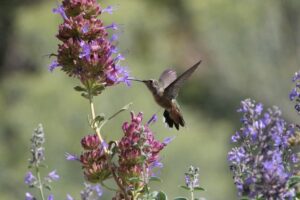
these birds must significantly increase their body weight. They do this by consuming large amounts of nectar and insects to build up fat stores. During migration, hummingbirds are known to stop frequently to feed, replenishing their energy by visiting flowers or nectar feeders.
The high energy requirements of hummingbird migration have led to fascinating adaptations. For instance, they have the ability to enter a state of torpor. Torpor is a temporary hibernation-like condition that allows them to conserve energy during long flights or overnight stops.
Food availability along the migration route plays a critical role in determining the success of the journey. During this time, hummingbirds rely heavily on the availability of flowering plants.
Human-provided nectar feeders can also play an important role in supporting their migration by providing much-needed sustenance along the way.
Challenges and Hazards of Migration
Migration is not without its dangers. Hummingbirds face a variety of challenges, many of which can have fatal consequences.
Weather: Severe weather, including storms and high winds, can make migration treacherous, especially for species that must cross large bodies of water or navigate through extreme temperatures. Cold temperatures and early frosts can be particularly dangerous for these tiny birds, whose small size makes it difficult for them to retain body heat.
Predation: While migrating, hummingbirds are vulnerable to predators such as larger birds, mammals, and even insects. Their small size makes them easy targets, particularly when they are exhausted after long flights.
Human-made Obstacles: One of the greatest threats to migratory birds is human activity. Urbanization, habitat destruction, and the proliferation of glass windows pose significant risks to hummingbirds during migration. Thousands of birds are killed each year by flying into buildings, especially in areas with tall glass structures.
Conservation of Migratory Hummingbirds
Hummingbird migration in the Gulf of Mexico
With declining populations of many bird species, conservation efforts for migratory hummingbirds have become increasingly important. Habitat loss due to urbanization, agriculture, and climate change poses significant challenges to these birds’ survival. Preserving natural habitats along migratory routes is crucial to ensuring that hummingbirds can continue their remarkable journeys.
- Creating Hummingbird Habitats: One of the most effective ways to support hummingbirds is by planting native flowering plants and creating hummingbird-friendly environments. These plants provide nectar for the birds and serve as critical stopover points during migration.
- Supporting Conservation Organizations: Many organizations are dedicated to the conservation of migratory birds, including the National Audubon Society, the Hummingbird Society, and others. Supporting these groups through donations or participation in citizen science projects can help further conservation efforts.
Conclusion
Hummingbird migration is one of nature’s most awe-inspiring phenomena, characterized by long-distance journeys, extraordinary navigation skills, and remarkable endurance. As they travel across vast distances, hummingbirds not only ensure their own survival but also play a vital role in pollinating plants along their migratory routes.
Understanding and protecting these tiny travelers is crucial, particularly in the face of climate change and habitat destruction. By supporting conservation efforts and providing suitable habitats, we can help ensure that hummingbirds continue to grace our skies for generations to come. As we marvel at the wonder of hummingbird migration, we are reminded of the way all living things are connected and the importance of preserving the natural world that sustains them.
A great book all about Bird migration
A fascinating look at North America’s famous natural spectacles
Bird migration captivates us. Where are the birds going? How far will they fly? How do they know when it’s time to leave―and how will they know when to return? Stan Tekiela has been studying and photographing birds of North America for more than 30 years. Now, the award-winning author and naturalist presents his insightful observations about migration and showcases them with his amazing images in a one-of-a-kind coffee-table book.
Click on the link for more information about hummingbird flight and migration
 source.
source.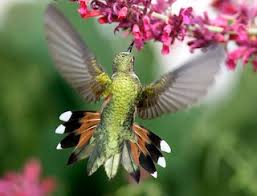 the winter.
the winter.
